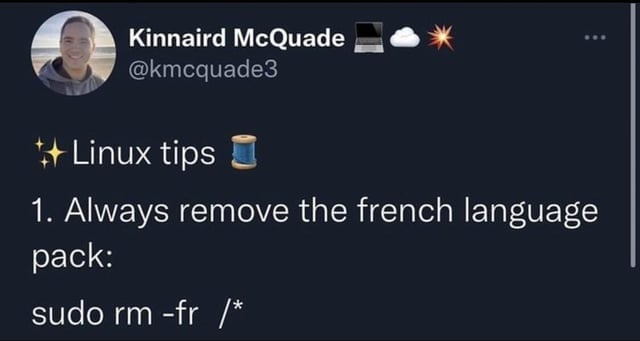this post was submitted on 12 Oct 2023
1230 points (94.5% liked)
linuxmemes
21291 readers
991 users here now
Hint: :q!
Sister communities:
- LemmyMemes: Memes
- LemmyShitpost: Anything and everything goes.
- RISA: Star Trek memes and shitposts
Community rules (click to expand)
1. Follow the site-wide rules
- Instance-wide TOS: https://legal.lemmy.world/tos/
- Lemmy code of conduct: https://join-lemmy.org/docs/code_of_conduct.html
2. Be civil
- Understand the difference between a joke and an insult.
- Do not harrass or attack members of the community for any reason.
- Leave remarks of "peasantry" to the PCMR community. If you dislike an OS/service/application, attack the thing you dislike, not the individuals who use it. Some people may not have a choice.
- Bigotry will not be tolerated.
- These rules are somewhat loosened when the subject is a public figure. Still, do not attack their person or incite harrassment.
3. Post Linux-related content
- Including Unix and BSD.
- Non-Linux content is acceptable as long as it makes a reference to Linux. For example, the poorly made mockery of
sudoin Windows. - No porn. Even if you watch it on a Linux machine.
4. No recent reposts
- Everybody uses Arch btw, can't quit Vim, and wants to interject for a moment. You can stop now.
Please report posts and comments that break these rules!
Important: never execute code or follow advice that you don't understand or can't verify, especially here. The word of the day is credibility. This is a meme community -- even the most helpful comments might just be shitposts that can damage your system. Be aware, be smart, don't fork-bomb your computer.
founded 1 year ago
MODERATORS
you are viewing a single comment's thread
view the rest of the comments
view the rest of the comments

In Linux, the root of the filesystem is /
The command would remove recursively every file/directory in the filesystem, essentially nuking the whole system.
Im not sure if it would delete the whole system. Isn't it more likely that it will destroy everything until it kills a file/directory necessary for the operation to run?
The reason you expect this is because Windows has a file lock behaviour that won’t let you delete a file when it’s in use, in Linux this limitation doesn’t exist.
Raymond Chan, arguably one of the best software engineers in the world, and a Microsoft employee, has repeatedly lamented the near malware like work arounds developers have had to invent to overcome this limitation with uninstallers.
Think about uninstalling a game. You need to run “uninstall.exe” but you don’t want uninstall.exe to exist after you’ve run it… but you can’t delete a file that’s in use. Uninstall.exe will always be in use when you run it….so how do you make it remove itself?
Schedule a task? Side load a process? Inject a process? Many ways…. But most look like malware.
Linux has never suffered this flaw.
I made a Batch uninstaller (to one of my other bat scripts I think), and it could remove itself without any problem just with the command "del whateverthenamewas.bat"
Yeah, because the bat file isn't actually running, it's just a list of commands cmd should execute.
Yup, CMD acts as a parser / runtime and the process is bound to the CMD binary, the script file is being run by CMD which keeps a copy of it in its own working memory in RAM